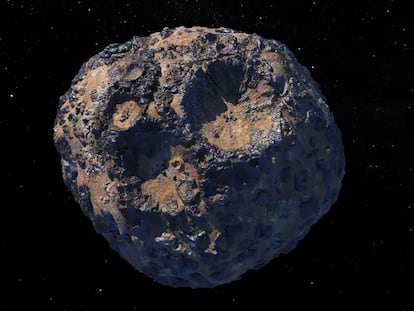Europa, one of Jupiter’s moons, has water, CO₂ and fascinating possibilities
The James Webb telescope just detected carbon dioxide on this Galilean satellite, one of the nearby worlds studied for extraterrestrial life

Observations from the James Webb telescope suggest the presence of CO₂ on the surface of Jupiter’s moon Europa. It is covered by a thick layer of ice under which there could be a global ocean.
This discovery opens up a number of fascinating possibilities. The CO₂ could be of external origin, but it could also have seeped through the subsurface (or sub-ice) itself. One explanation is that Europa’s ocean contains large amounts of dissolved CO₂, as is the case with terrestrial oceans. The other more intriguing explanation is that it is a by-product of the decomposition of organic compounds, not living things, of course, but simply carbon compounds such as amino acids or other similar compounds.
The deposits are concentrated in an area called Tara Regio and are relatively recent. The prevailing conditions on Europa’s surface mean that CO₂ is not stable for long. Geyser eruptions, such as those occurring on Enceladus, are not common on Europa, which is unfortunate because their spectrographic analysis would help to establish the existence of dissolved salts, like the sodium chloride in our seas.
Today, it is taken for granted that there are at least three worlds in the solar system with global oceans under the surface: Jupiter’s moons Europa and Ganymede and Saturn’s Enceladus. Scientists suspect that the same is true for two others, although the evidence is less conclusive: Callisto, on Jupiter, and Titan, on Saturn. There are also other possible candidates for which we have insufficient data: Triton, which revolves around icy Neptune and some others such as Dione; and the dwarf planets Ceres and Pluto.
There were already hints of the possibility of a global ocean on Europa over 25 years ago, when the Galileo probe, which orbited around Jupiter, passed within a short distance of that moon (about 5,300 kilometers) and transmitted detailed photographs of its icy surface. Some of those images showed what came to be called “ice rafts.”
That was the name given to fragments of a few kilometers that were reminiscent of the tabular icebergs that form in the Arctic during the spring thaw. But in this case, they did not float freely but instead appeared to have refrozen in random positions: the grooves running across their surface had broken and shifted like a badly assembled puzzle, and between the original slabs there were areas where the ice had re-formed without a definite structure.

This chaotic picture suggested that the ice cover was relatively thin, perhaps a few kilometers. Some estimate it to be only a few hundred meters. Beneath the ice lurks a deep ocean, which models estimate to be 80 to 150 kilometers deep. If confirmed, little Europa could contain two or three times as much water as all the oceans on Earth.
The existence of such a liquid ocean also implies some source of heat. Galilean satellites are icy worlds with rocky, not igneous cores. The only possibility is that the heat comes from other sources, such as the gravitational pressure that Jupiter exerts on them.
Due to the effect of tidal forces, most moons always keep the same face toward the planet. That face also presents a certain bulge precisely because of this attraction. Io, Europa, and Ganymede (in order of proximity to Jupiter) also share an orbital resonance phenomenon. For every revolution completed by Ganymede, Europa makes two, and Io makes four. This causes them to align with a certain frequency and their respective gravitational pull deforms their orbits, making them somewhat more eccentric.
The result is that as it travels in its orbit, the planet’s gravitational pull combined with the different moon velocity causes intense deformations in it. It is estimated that the Io’s surface rises and falls like an elevator up to 100 meters at a time. The friction of the rocks in its interior can raise the temperature up to 2,000 degrees in the core. With 150 active craters at any one time, Io is the most volcanic body in the solar system. And it is only slightly larger than our moon.

A similar but much less intense effect occurs on Europa and contributes to keeping the subsurface ocean liquid. In 2012, the Hubble telescope identified water vapor emissions from its south pole, which the Galileo probe had never detected, during its eight years in orbit around Jupiter.
But Galileo did contribute to the discovery of Europa’s ocean with another instrument: its magnetometer. Designed to study Jupiter’s brutal magnetic field, this equipment detected small irregularities as it passed close to Europa. Clearly, there was another field interfering with the main one. And that could only be caused by the presence of electrical currents inside the moon.
Pure water is not an electrically conductive medium, but it is when it contains dissolved salts. If there are large deposits of water under Europa’s ice, the Jovian magnetic field itself would induce weak currents that, in turn, would be responsible for the anomalies detected by the magnetometer.
Europa’s ice shell “decouples” its surface from the rocky rest of the star. The cracks seen in it may be scars left by tidal movements (three times less intense than on Io) and the earthy color seen in some of them may correspond to salt deposits upwelling from the interior. The Galileo probe took several spectra suggesting the presence of calcium and magnesium sulfates.
In any case, it was a very slight effect, much less than the same probe detected on Ganymede. This is a much larger world, even larger than the planet Mercury. In 2015, the Hubble telescope detected the surprising presence of auroras over the dark hemisphere. That allowed for a new analysis of its magnetic field, indicating the presence of a hidden ocean, as on Europa, and, in all probability, a metallic core composed of iron and nickel.
Ganymede’s ocean may be even deeper than Europa’s, at up to 300 kilometers, or three times deeper than the Mariana Trench. At the bottom, the pressure is inconceivable. If the concentration of salts is high, the combined effect of both can cause the appearance of layers of very dense ice alternating with large volumes of water, as if it were a huge onion.
The densest ice, called ice VI, is so dense that it does not even float on water. If it exists at the bottom of Ganymede, it can reach down to the icy layer surrounding the metallic core. Above, at lower pressure levels, the water would freeze into other forms of ice, very dense due to the presence of salts. When these eventually precipitate, the lightened ice would float as if it were snowing “upward,” a phenomenon that is probably unique in the solar system.

If Ganymede’s ocean extends into the mantle, dissolved salts would be the only type of nutrient that could be expected to support hypothetical life forms. But that is a very insufficient resource. For that reason, when the JUICE probe mission now underway ends, it will be crashed into Ganymede, where the danger of biological contamination seems lower (unless it sends back data that forces a change of plans).
The situation is different on Europa. The depths of Europa’s ocean may be in contact with a rocky bottom. That’s where fascinating possibilities open up. For example, the presence of hydrothermal vents (similar to the ones discovered on Earth) are capable of providing minerals and energy to create a whole ecosystem of their own, independent of sunlight, which, of course, would not reach such depths. Europa’s internal heat, generated by tidal bending, would be sufficient to feed these jets, and ocean currents would distribute the nutrients throughout the seafloor.
There are even more exotic candidates as well. Titan is an icy world that has an oxygen-deprived atmosphere and hydrocarbon-based weather. Tiny Enceladus is a more promising option, especially since it has been confirmed that salt water exists beneath its icy crust; this water frequently surfaces through the fissures that run along its south pole. Exobiology, which until recently was very speculative, is on its way to becoming experimental.
Sign up for our weekly newsletter to get more English-language news coverage from EL PAÍS USA Edition
Tu suscripción se está usando en otro dispositivo
¿Quieres añadir otro usuario a tu suscripción?
Si continúas leyendo en este dispositivo, no se podrá leer en el otro.
FlechaTu suscripción se está usando en otro dispositivo y solo puedes acceder a EL PAÍS desde un dispositivo a la vez.
Si quieres compartir tu cuenta, cambia tu suscripción a la modalidad Premium, así podrás añadir otro usuario. Cada uno accederá con su propia cuenta de email, lo que os permitirá personalizar vuestra experiencia en EL PAÍS.
¿Tienes una suscripción de empresa? Accede aquí para contratar más cuentas.
En el caso de no saber quién está usando tu cuenta, te recomendamos cambiar tu contraseña aquí.
Si decides continuar compartiendo tu cuenta, este mensaje se mostrará en tu dispositivo y en el de la otra persona que está usando tu cuenta de forma indefinida, afectando a tu experiencia de lectura. Puedes consultar aquí los términos y condiciones de la suscripción digital.
More information
Archived In
Últimas noticias
There is as much life left to discover on planet Earth as that which is already known
Dozens presumed dead, around 100 injured in fire at Swiss Alps bar during New Year’s celebration
Is porn for women different from conventional porn? We spoke to those who make it
Cartagena de Indias is sinking: What can the city do to mitigate it?
Most viewed
- Reinhard Genzel, Nobel laureate in physics: ‘One-minute videos will never give you the truth’
- David King, chemist: ‘There are scientists studying how to cool the planet; nobody should stop these experiments from happening’
- Sinaloa Cartel war is taking its toll on Los Chapitos
- Oona Chaplin: ‘I told James Cameron that I was living in a treehouse and starting a permaculture project with a friend’
- The Interoceanic Train, the Mexican alternative to the Panama Canal











































